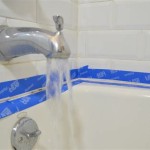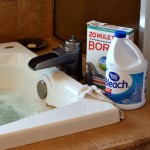Silicone Sealant Bathtubs: A Comprehensive Guide for Homeowners
Bathtubs are an essential part of any bathroom, providing a place to relax and rejuvenate after a long day. However, it's not just about soaking in the tub; maintaining its structural integrity and longevity is also crucial. This is where silicone sealant comes into play.What is Silicone Sealant?
Silicone sealant is a flexible, waterproof material used to fill gaps and joints between surfaces. In the context of bathtubs, it is primarily applied to seal the gap between the tub and the surrounding wall or tiles. This prevents water from seeping into the gap and causing damage to the underlying structure.Benefits of Using Silicone Sealant in Bathtubs
*Prevents Water Damage:
As mentioned earlier, silicone sealant acts as a water-tight barrier, preventing water from seeping into the gap between the tub and the wall. This helps protect the surrounding structure from moisture-related issues such as mold, mildew, and rot. *Prevents Leaks:
By properly sealing the gaps, silicone sealant prevents leaks that could potentially cause water damage to your bathroom floor and walls. This ensures a safe and functional bathing experience. *Improves Aesthetics:
A well-sealed bathtub with a neat and clean silicone sealant line enhances the overall aesthetics of your bathroom. It provides a seamless and professional-looking finish that complements the design of your bathroom. *Prevents Unwanted Odors:
When water seeps into the gaps between the tub and the wall, it can create a breeding ground for mold and mildew, leading to unpleasant odors in the bathroom. By sealing these gaps, silicone sealant helps prevent these odors and keeps your bathroom smelling fresh and clean.Choosing the Right Silicone Sealant
Selecting the right silicone sealant for your bathtub is essential to ensure its effectiveness and longevity. Here are some factors to consider: *Type of Silicone Sealant:
There are various types of silicone sealants available, such as acetoxy-cure, alkoxy-cure, and neutral-cure sealants. For bathtubs, neutral-cure silicone sealants are typically recommended as they are more flexible and less likely to crack or deteriorate over time. *Color:
Silicone sealants come in a wide range of colors to match the color of your bathtub and bathroom tiles. Choose a color that blends seamlessly to create a cohesive look. *Quality:
Opt for high-quality silicone sealant from reputable manufacturers. This ensures that the sealant is durable and provides long-lasting performance.Applying Silicone Sealant to Your Bathtub
Applying silicone sealant to your bathtub is a relatively simple process, but it requires careful attention to detail. Here's a step-by-step guide: 1.Prepare the Surface:
Clean the area around the bathtub thoroughly to remove any dirt, grime, or old sealant residue. Ensure the surface is dry before applying the sealant. 2.Apply Painter's Tape:
Apply painter's tape along the edges of the tub and the wall to create a clean and precise line for the sealant. This will prevent the sealant from spreading beyond the desired area. 3.Cut the Sealant Tube:
Cut the tip of the sealant tube at a 45-degree angle, ensuring the opening is large enough to apply a consistent bead of sealant. 4.Apply the Sealant:
Hold the sealant tube at a 45-degree angle and apply a continuous bead of sealant along the gap between the tub and the wall. Press the sealant firmly into the gap, ensuring it makes good contact with both surfaces. 5.Smooth the Sealant:
Use your finger or a sealant smoothing tool to smooth out the sealant, creating a neat and even surface. Remove the painter's tape immediately while the sealant is still wet. 6.Allow the Sealant to Cure:
Refer to the manufacturer's instructions for the curing time of the sealant. Typically, it takes 24 to 48 hours for the sealant to fully cure and reach its maximum strength.Maintenance and Care
To ensure the longevity of your silicone sealant, regular maintenance and care are essential: *Clean the Sealant Regularly:
Use a mild detergent and a soft cloth to clean the sealant periodically. Avoid using abrasive cleaners or harsh chemicals, as they can damage the sealant. *Inspect the Sealant for Cracks or Gaps:
Regularly inspect the sealant for any cracks or gaps. If you notice any damage, apply a fresh bead of sealant to repair the affected area promptly. *Prevent Contact with Harsh Chemicals:
Avoid exposing the sealant to harsh chemicals, such as bleach or strong acids, as these can degrade the sealant over time. By following these tips, you can ensure that your silicone sealant bathtub remains in pristine condition, providing years of reliable service and enhancing the overall beauty of your bathroom.
How To Seal A Bath Properly
Top Tip On How To Apply Silicone Sealant With Step By Pictures

Ge Supreme Silicone 10 1 Oz White Kitchen And Bath Caulk 2709108 The Home Depot

Bath Silicone Sealant Diy Bostik

Ge Silicone Ii Multi Purpose Kitchen Bath Sealant Waterproof Caulk Almond 299 Ml Canadian Tire

Caulk Or Sealant Which Is Right For Your Bathtub Badeloft

Ge Silicone Ii 299 Ml Bathtub Sealant White Rona

How To Caulk A Bathtub Like Pro

Tommy S Trade Secrets How To Silicone A Bath

Ge Silicone Ii 299 Ml Bathtub Sealant White Rona








